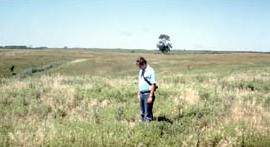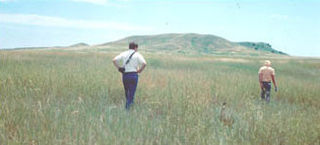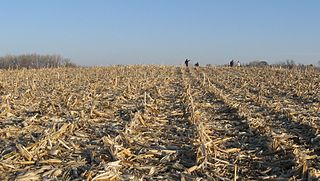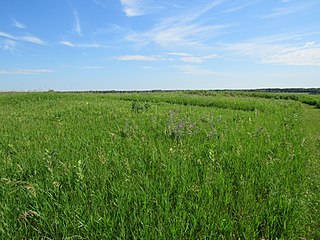Related Research Articles

The Hagen Site, also designated by the Smithsonian trinomial 24DW1, is an archaeological site near Glendive in Dawson County, Montana. The site, excavated in the 1930s, is theorized to represent a rare instance of a settlement from early in the period in which the Crow and Hidatsa Native American tribes separated from one another. It was declared a National Historic Landmark in 1964.

The Brooks River Archaeological District encompasses a large complex of archaeological sites along the banks of the Brooks River in Katmai National Park and Preserve in the U.S. state of Alaska. It includes at least twenty separate settlement sites with documented occupation dates from 2500 BCE to recent (post-contact) history. It was declared a National Historic Landmark in 1993. The site is partly occupied by the Brooks Camp, one of the major visitor areas of the park.

The Onion Portage Archeological District encompasses a major archaeological site in Kobuk Valley National Park in northwestern Alaska. The site is a deeply stratified site, at which archaeologists have located nine complexes ranging dating from approximately 6500BC to AD1700. The site has been of critical benefit for the study of Arctic cultures, and is used to determine the cultural chronology of the region.

The Arzberger site, designated by archaeologists with the Smithsonian trinomial 39HU6, is a major archaeological site in Hughes County, near Pierre, South Dakota. It was declared a National Historic Landmark in 1964. It is a large fortified village, that is the type site for the Initial Coalescent, a culture that flourished in the area c. 1200-1350 CE.
The Vanderbilt Archeological Site is an archaeological site located on the shore of Lake Oahe in Campbell County, South Dakota, near Pollock, South Dakota. The site contains the remains of a Native American Plains village which has been tentatively dated to about 1300 AD. Despite the fact that the site is subject to erosive destruction from wave action on the lake, it has been determined likely to yield significant information about the movements and living patterns of prehistoric Native Americans in the region. The site was declared a National Historic Landmark in 1997.

The Bloom Site, designated by the Smithsonian trinomial 39HS1, is an archaeological site in Hanson County, South Dakota. It was declared a National Historic Landmark in 1964.

The Langdeau Site, designated by the Smithsonian trinomial 39LM209, is an archaeological site in Lyman County, South Dakota, near Lower Brule. It was declared a National Historic Landmark in 1964. The site was one of the first to provide evidence of horticultural activity by Native Americans in the region.

This is a list of the National Register of Historic Places listings in Jefferson County, Missouri.

The DIL-161 Site is a prehistoric archeological site in Katmai National Park and Preserve. Located on the banks of the Alagnak River, the site was first identified in 1997 by National Park Service personnel, and its extents were mapped in 2004. The site is that of a village that was occupied between about 300 BCE and 800 CE. More than 40 cabin sites, which are little more than house pits, have been identified.

The Snake River Archaeological District is an archaeological area located in Nez Perce County, Idaho, and Asotin County, Washington, and centered on the Snake River, which divides the two states. The area includes a number of sites inhabited by the Nez Perce people, who used it as a fishing ground and a winter campsite. Settlement in the area stretches from roughly 6000 B.C. to the 20th century A.D. Several hundred pictographs are part of the area, usually painted at village sites.
Takli Island is an island off the southern coast of the Alaska Peninsula in the Shelikof Strait of southwestern Alaska. It is located at the mouth of Amalik Bay, off the mainland portion of Kodiak Island Borough, in Katmai National Park and Preserve. The area was first archaeologically investigated in the 1960s, when the prehistory of the area was little known, and the island's sites are type sites for a series of archaeological cultures.

St. Michael Redoubt was a fortified trading and supply post established by the Russian-American Company in 1833, at the location of what is now the city of St. Michael, Alaska. It is located on the southern shore of Norton Sound at a convenient location near the mouth of the Yukon River. The fort, established by order of Ferdinand Wrangel, was used in following decades as a logistics point for exploration of southwestern Alaska and the Alaskan interior via the Yukon and other rivers.
The Savonoski River Archeological District encompasses a complex of prehistoric and historic archaeological sites on the Savonoski River near the mouth of the Grosvenor River in Katmai National Park and Preserve, located on the Alaska Peninsula of southwestern Alaska. At least two sites, designated 49-MK-3 and 49-MK-4 by state archaeologists, were identified when the site was listed in 1978. In 2003, the district was enlarge to include a third site, XMK-53. This area is believed to be the site of one of a group of Native Alaskan settlements referred to in Russian records as "Severnovsk". Excavations of a known prehistoric site in 1964 uncovered additional evidence of a post-contact settlement.

Kimball Village is an archaeological site located in the vicinity of Westfield, Iowa, United States. It is one of six known Big Sioux phase villages from the Middle Missouri tradition that existed between 1100-1250 C.E. The site, located on a terrace overlooking the Big Sioux River, has well-preserved features, including earth lodge and storage pits, and evidence of fortifaction. The site was listed on the National Register of Historic Places in 2010, and as a National Historic Landmark in 2016.
The Winooski Archeological Site, designated VT-CH-46 by state archaeologists, is a prehistoric Native American site in the city of Winooski, Vermont. First identified in 1972, it is one of the largest Native encampment sites of the Middle Woodland period in the northeastern United States. It was listed on the National Register of Historic Places in 1978, at which time it was recognized as one of just two stratified Woodland period sites in the state.
The Four Mounds site is a historic site located in Dubuque, Iowa, United States. It is made up of a row of four conical burial mounds on a blufftop that overlooks the Mississippi River. They are prehistoric in their origin. The site was individually listed on the National Register of Historic Places in 2000. It was included as a contributing property in the Four Mounds Estate Historic District in 2002.

Fort Juelson, designated 21OT198 in the state archaeological inventory, is a historic site located east of Underwood, Minnesota, United States. An earthen fort was built at this hilltop in July 1876 after rumors of Indian attacks in Foxhome, French, and Fergus Falls following the Battle of Little Bighorn in Montana. Many settlers left the area. Charles A. Dollner, a local merchant, suggested the rest of the people band together and build the fortification under leadership of two American Civil War veterans, Hans Juelson and Berge O. Lee. The scare proved to be a hoax, and the fort was never used for defensive purposes. Remnants of the sod barricade are still on the site.
Morrison Mounds is a historic site located north of Battle Lake, Minnesota, United States. It consists of 22 Indian burial mounds that were built beginning in 800 B.C. There are 20 conical mounds, one flat-topped mound, and one elongated mound near Otter Tail Lake. This site has the oldest radiocarbon date for any mound group in the state of Minnesota. However, its construction is similar to other mound groups in the area which suggests they are all from the same social group that built them over a period of time. Similarities include a central burial pit, logs over the burial pit, and the possibility of partial cremation on-site. The site was listed on the National Register of Historic Places in 1973.
The Rosenstock Village site is a historic site located in Frederick County, Maryland, United States, near the city of Frederick. It contains the remains of a Late Woodland Village situated on a bluff overlooking the Monocacy River. The village was occupied between A.D. 1335 and A.D. 1400, based on artifact analysis and radiocarbon dating. It is similar to the Montgomery Complex, which is a cultural complex made up of Late Woodland sites located on the Potomac River. The site was excavated in 1979 and from 1990 to 1992, and estimates suggest that 93% of the site remains undisturbed. They uncovered a large oval area surrounded by pits, a large sheet midden area, and what are believed to be two sweatlodges. The excavations have yielded a trove of artifacts and animal remains. The site was listed on the National Register of Historic Places in 2018.

This is a list of the National Register of Historic Places listings in Copper River Census Area, Alaska.
References
- ↑ Federal and state laws and practices restrict general public access to information regarding the specific location of this resource. In some cases, this is to protect archeological sites from vandalism, while in other cases it is restricted at the request of the owner. See: Knoerl, John; Miller, Diane; Shrimpton, Rebecca H. (1990), Guidelines for Restricting Information about Historic and Prehistoric Resources, National Register Bulletin, National Park Service, U.S. Department of the Interior, OCLC 20706997 .
- 1 2 "National Register Information System". National Register of Historic Places . National Park Service. July 9, 2010.
- ↑ Michael L. Gregg and Amy Bleier (2008). "The Little Missouri River Study Unit" (PDF).
